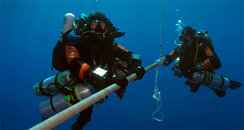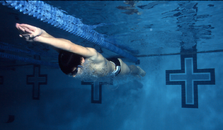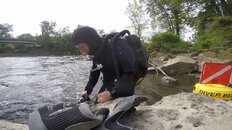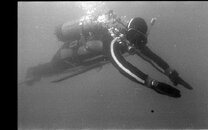That's 4.5 knots. This makes my 3 knot cruising speed look fairly attainable, as I've claimed it would be if we tried to reach it.That (05:46.96 for 800 meters) is probably the outside limit for humans for a cruising speed.
You are using an out of date browser. It may not display this or other websites correctly.
You should upgrade or use an alternative browser.
You should upgrade or use an alternative browser.
Diving Performance - Beyond Drag (article Series And Discussion)
- Thread starter REVAN
- Start date
Please register or login
Welcome to ScubaBoard, the world's largest scuba diving community. Registration is not required to read the forums, but we encourage you to join. Joining has its benefits and enables you to participate in the discussions.
Benefits of registering include
- Ability to post and comment on topics and discussions.
- A Free photo gallery to share your dive photos with the world.
- You can make this box go away
From information in my aerodynamics book, the scoop may have the ability to generate a drag force maybe 30% larger than a flat fin. That's useful if your fin size is constrained, but I don't think that size is a particular constraint, or limit that divers need to be concerned with. Although, it seems like it could be a benefit in underwater hockey.I would be interested in your feedback.
For efficiency with a bi-fin, I like the concept of the long blade. This design sets up vortices along the edges of the fin, amplifying it along its length, and then rotates the vortices at the end of the fin blade to generate a thrust vector. To accomplish this with full potential, the fin needs to be long enough to span about 1/2 of the total stroke cycle. As the fin gets shorter than this, it looses the rolling action and starts functioning more as a paddle instead, which is going to be less efficient.
The other option is to make a foil instead, which is what I did with my monofins. Making foils work well is a bit more tricky, I think. But done right, the results can be excellent.
There was more information in the original draft of part 4 in the pdf file. For some reason, the published article was missing some pictures, one of them with more information on the fins.Revan, maybe I missed it, did you go into any detail on your bi-fins ?
Here it is again so you don't have to find the other post.
Attachments
Earlier, there was question of the 1 knot swimming speed and if that was accurate for recreational diving. I found this post on swimming speeds from another thread here on SB.
That works out to 0.8 knots. The Tahoe track is cold water, so these test swims were done in drysuits. The benchmark testers are experienced and physically fit divers.
Incidentally, I swam the Tahoe test track at 1.5 knots in an OS Systems tri-laminate style dry suit (the draggy type) at 1.5 knots. I did this with a DOL-Fin HP monofin, an early version of DOL-Fin. That's almost double the speed of the benchmark testers. I had an aluminum 80, a little larger than a steel 72.
During testing for the Tahoe Benchmark, we asked test divers to swim over our surveyed test track. They were instructed to swim "at a steady pace to cover the most ground without urgency".
82 feet per minute, in a single steel 72, BP/W & drysuit.
All the best, James
That works out to 0.8 knots. The Tahoe track is cold water, so these test swims were done in drysuits. The benchmark testers are experienced and physically fit divers.
Incidentally, I swam the Tahoe test track at 1.5 knots in an OS Systems tri-laminate style dry suit (the draggy type) at 1.5 knots. I did this with a DOL-Fin HP monofin, an early version of DOL-Fin. That's almost double the speed of the benchmark testers. I had an aluminum 80, a little larger than a steel 72.
Last edited:
I am curious about the first highlighted statement. That is because I don't think of the scoop fin as generating drag, but rather channeling water to the rear for propulsion.From information in my aerodynamics book, the scoop may have the ability to generate a drag force maybe 30% larger than a flat fin. That's useful if your fin size is constrained, but I don't think that size is a particular constraint, or limit that divers need to be concerned with. Although, it seems like it could be a benefit in underwater hockey.
For efficiency with a bi-fin, I like the concept of the long blade. This design sets up vortices along the edges of the fin, amplifying it along its length, and then rotates the vortices at the end of the fin blade to generate a thrust vector. To accomplish this with full potential, the fin needs to be long enough to span about 1/2 of the total stroke cycle. As the fin gets shorter than this, it looses the rolling action and starts functioning more as a paddle instead, which is going to be less efficient.
The other option is to make a foil instead, which is what I did with my monofins. Making foils work well is a bit more tricky, I think. But done right, the results can be excellent.
Concerning the efficiency of the long blade, I have used the long blade in my surface swims in the 1980s. My longest was called the "Vets Swim for the Needy," from Elkton to the Oregon coast on the Umpqua River. It was about a 15 mile swim, and the long blade handled it well. I was the only finisher, and got some flak for continuing the swim from my wife, who was at home with my in-laws for that swim.
But I also note that fish usually use a version of the scoop for their fin, and that they are faster than those fish (eels) which use the long concept.
SeaRat
I am curious about the first highlighted statement. That is because I don't think of the scoop fin as generating drag, but rather channeling water to the rear for propulsion.
I used the word drag with hesitation. People tend to think that lift and drag are inherently different somehow. Both resolve down to a momentum transfer of fluid. The difference between lift and drag is the direction of the force relative to the far-field direction of fluid flow. With a high aspect ratio foil, the force (which we call lift) is mostly perpendicular to the far-field flow, where a force we would call drag is mostly inline. A low aspect ratio shape like a scuba fin will have the net fluid force split about equally between the 2 extremes. So, what do we call it in the case of a scuba fin?
Most people use scuba fins, pretty much like a paddle (they are sometimes even referred to as paddle fins). So, I tend to use the terminology of drag, as that term is appropriate in that case. However, low amplitude rapid kicking that approaches the limit I mentioned previously, where the fin length is on the same order as 1/2 kick cycle, it starts working like a flexible foil where the leading edges of the "foil" are actually the side edges for the fin blade. Alternately, the fin can be made long enough to attain this effect with a slower and more comfortable kick stroke and that is where long blade freediving fins come from.
I'd just assume use the term momentum transfers instead of lift and drag when talking about fins, but I figure many people would get confused.
Revan, I think the confusion is because drag has been used to describe water flow resistance that slows a diver down. For example, gear hanging down off a diver creates drag or resistance against the water flow.
Most of us don't have any knowledge of aerodynamics so when you talk about aerodynamic drag, lift, foil, we don't know what you are talking about. If I understand you correctly, there is more than one way to move a diver forward ? A shorter fin might work well using John's scoop, while a longer fin works differently ? Both move a diver forward, but in different ways ?
Most of us don't have any knowledge of aerodynamics so when you talk about aerodynamic drag, lift, foil, we don't know what you are talking about. If I understand you correctly, there is more than one way to move a diver forward ? A shorter fin might work well using John's scoop, while a longer fin works differently ? Both move a diver forward, but in different ways ?
Last edited:
To simplify this discussion, we are trying to get away from the Tech diver configurations, shown below, and more toward what my son Nathan Ratliff demonstrated when he was a swim team member, and streamlining off a turn.
Ravan, I have watched several of your videos, including the one on your Facebook page of swimming with dolphins using your second generation modification to the tank. It is quite impressive.
You and I have much the same ideas, but our implementation is a bit different. I have not yet modified the tank with a cowling (although I use one effectively on my recumbant bicycle). I have dropped the tank lower on my back, which puts it more behind my head than above it when I swim. This simple idea gets the tank lower, and exposes less of it to the frontal surface area of the diver.
I have done a lot of experimentation in the last two years with the Nautilus Constant Volume System by Dacor, which is a hard-shell BC based upon submarine concepts. Dacor claimed that, because it was hard-shell and somewhat hydrodynamic, water flowed around it better than the soft wing BCs then (and currently) being used. It was a complex BC, and so fell out of favor, but it actually does perform pretty well in current. It is not as good as the configurations I have worked out, which will come in a separate post.
I have done extensive work with the Aqueon in the 1970s and 1980s (bought it new), and actually have one (although it is disassembled now, for reasons which will become obvious later). The Aqueon, and its successor PowerSwim from DARPA, is advertised as an advance. "This crazy fin thing was developed by DARPA for scuba divers to swim 150% faster and with less effort than regular fins, helping to get places quicker and preserve oxygen along the way." It has two important limitations. One has to do with the kick, which is limited by the "throw" of the propulsive blade into the diver's abdomen/chest area. That means that the diver cannot kick further downward and get propulsion. The other is that it obstructs the bending at the hips, so a surface dive, or other acrobatics underwater (such as the flip turn that finswimmers rountinely use) is impossible. By the way, a 150% boost is speed underwater is not what we are after; rather, we want a 200-300% increase is speed (velocity) underwater.
More later.
SeaRat
Ravan, I have watched several of your videos, including the one on your Facebook page of swimming with dolphins using your second generation modification to the tank. It is quite impressive.
You and I have much the same ideas, but our implementation is a bit different. I have not yet modified the tank with a cowling (although I use one effectively on my recumbant bicycle). I have dropped the tank lower on my back, which puts it more behind my head than above it when I swim. This simple idea gets the tank lower, and exposes less of it to the frontal surface area of the diver.
I have done a lot of experimentation in the last two years with the Nautilus Constant Volume System by Dacor, which is a hard-shell BC based upon submarine concepts. Dacor claimed that, because it was hard-shell and somewhat hydrodynamic, water flowed around it better than the soft wing BCs then (and currently) being used. It was a complex BC, and so fell out of favor, but it actually does perform pretty well in current. It is not as good as the configurations I have worked out, which will come in a separate post.
I have done extensive work with the Aqueon in the 1970s and 1980s (bought it new), and actually have one (although it is disassembled now, for reasons which will become obvious later). The Aqueon, and its successor PowerSwim from DARPA, is advertised as an advance. "This crazy fin thing was developed by DARPA for scuba divers to swim 150% faster and with less effort than regular fins, helping to get places quicker and preserve oxygen along the way." It has two important limitations. One has to do with the kick, which is limited by the "throw" of the propulsive blade into the diver's abdomen/chest area. That means that the diver cannot kick further downward and get propulsion. The other is that it obstructs the bending at the hips, so a surface dive, or other acrobatics underwater (such as the flip turn that finswimmers rountinely use) is impossible. By the way, a 150% boost is speed underwater is not what we are after; rather, we want a 200-300% increase is speed (velocity) underwater.
More later.
SeaRat
Attachments
Last edited:
Neat. I didn't know about that system. I had been considering something along those lines, as that concept could fix some of what I don't like about BCs. The problem with this Dacor unit is that it has WAY too much buoyancy. I don't need or want 60 pounds of buoyancy control. I'd want about 10 pounds at the most. It's supposed to be buoyancy control, not a boat. If I can't get my weighting right to within 10 pounds of where it should be, I probably shouldn't be diving in the first place.I have done a lot of experimentation in the last two years with the Nautilus Constant Volume System by Dacor, which is a hard-shell BC based upon submarine concepts.
Similar threads
- Replies
- 0
- Views
- 667
- Replies
- 117
- Views
- 6,544
- Replies
- 3
- Views
- 1,041
- Replies
- 21
- Views
- 1,302
- Replies
- 0
- Views
- 696







